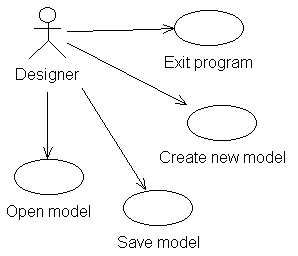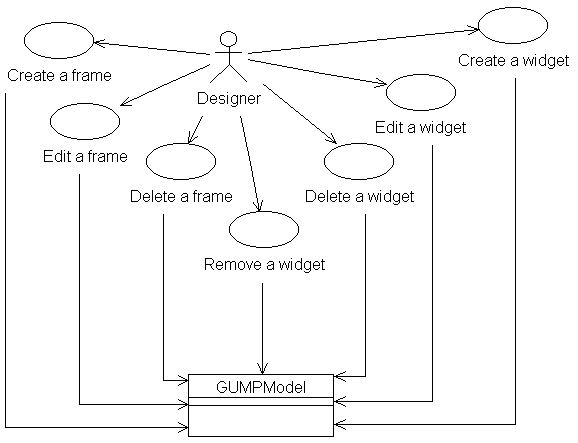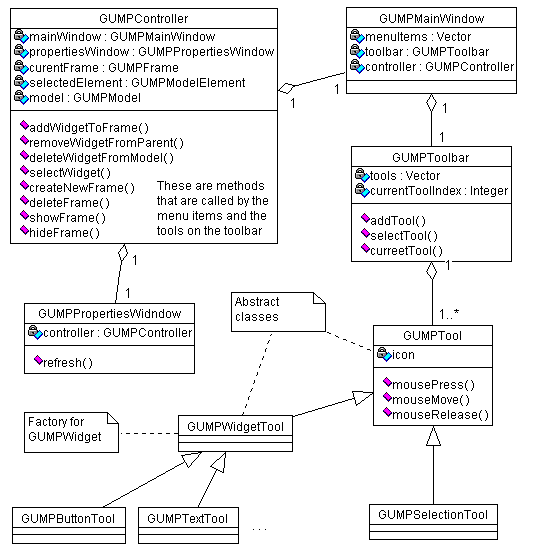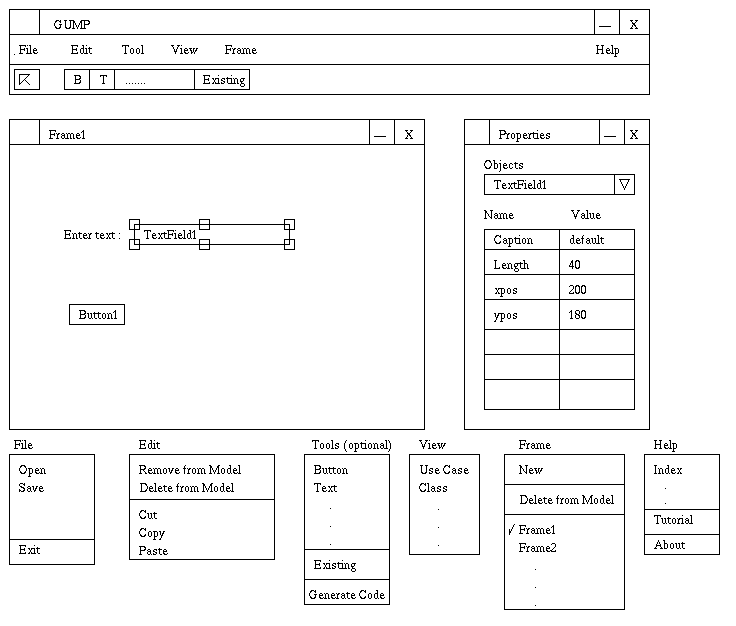Use case diagrams
The basic overall use cases are illustrated in Figure 1. The designer (the user of GUMP) should be able to create a new model, open a model, save a model, and exit the program.
 |
| Figure 1. |
The use cases that modify the model are illustrated in Figure 2. These fall within the overall use case of creating a new model. All of them have to do with building a user interface, and all of them have an effect on the underlying model that represents the user's work.
 |
| Figure 2. |
Class diagrams
The class diagram of the model and its related classes are in Figure 3. The ModelElement class is part of the ISE project that we had to extend in order to integrate with it. The GUMPProperty class gives us the greatest flexibility and ease of coding for subclasses with different attributes. For convenience's sake, we have included references to GUMPWidgets both in the GUMPModel (through inheritance from GUMPModelElement) and in the GUMPFrame. We also did not want to have any part of Swing tied into the model (as in the GUMPFrame class, which has a JFrame field frame), but found no way to get around it.
 |
| Figure 3. |
The class diagram of the view and controller and related classes are in Figure 4. [Note: the class structure has changed a bit since this diagram was made. The main change is that GUMPMainWindow assimilated GUMPToolbar.] The GUMPController handles all events and in general controls everything, dispatching messages to all the other appropriate classes. For example, it delegates all mouse events on the active frame to the currently selected GUMPTool object. The currently selected subclass of GUMPTool handles those events, polymorphically selecting the proper actions based on the tool. The GUMPPropertiesWindow updates itself on demand from the controller, and modifies properties on the selected element when the user changes the values in its table.
 |
| Figure 4. |
Attached is the full class diagram, which encompasses and relates these two subdiagrams. It has been updated to reflect several changes since the above two diagrams were made.
Class dictionary
GUMP Model
CLASS: ModelElementThis is an external class which is already a part of the ISE package. It is included in this object design dictionary for completeness, since GUMPModelElement is a subclass of ModelElement.
CLASS: GUMPModelElement ("IS-A" ModelElement)
GUMPModelElement is a child class of ModelElement. It is an abstract
class which contains a vector of GUMPProperties, and accessor methods to
allow this vector to be enumerated, or to add properties to this vector.
- Data members:
- Vector properties
- Methods:
- getProperty() : get the value of a property
setProperty() : set the value of a property
enumerateProperties() : get all properties from the vector
CLASS: GUMPFrame ("IS-A" GUMPModelElement)
GUMPFrame represents the frame displayed on the screen to which
various widgets are added by the user. It is a subclass of
GUMPModelElement. It contains a vector of those widgets which it
contains, and a JFrame which is the SWING representation of this GUMPFrame
once it is displayed on the desktop.
- Data members:
- Vector widgets
JFrame frame
CLASS: GUMPWidget ("IS-A" GUMPModelElement)
GUMPWidget is an abstract class which contains information common to
all types of widgets placed by the user on the frame.
- Data members:
- GUMPFrame parent : the frame which is the widget's geometrical parent (that is, the frame which contains the widgets)
- Methods:
- draw() : allows the widget to draw itself on the frame
refresh() : causes the widget to refresh the properties of the Swing widget from the GUMPWidget's own set of properties
CLASS: GUMPText ("IS-A" GUMPWidget)
GUMPText represents a SWING textbox widget.
- Data members:
- Swingtext textbox : the SWING representation of the GUMPText
CLASS: GUMPButton ("IS-A" GUMPWidget)
GUMPButton represents a SWING pushbutton widget.
- Data members:
- Swingbutton button : the SWING representation of the GUMPButton
CLASS: GUMPModel
GUMPModel contains a Vector of GUMPModelElements which exist in the
current view. It contains accessors to these elements, and also allows
the current collection of elements to be saved to the ISE database.
- Data members:
- Vector elements : the collection of GUMPModelElements
- Methods:
- addElement() : adds an element the elements Vector
getElements() : returns all elements currently in the Vector
removeElement() : removes an element from Vector elements
save() : saves the current GUMP frame and all its widgets and properties to the database
CLASS: GUMPProperty
This class contains the name and value of a single property of a
GUMPModelElement. A collection of GUMPProperties is stored in
GUMPModelElement.properties.
- Data members:
- String Name
String Value
GUMP View
CLASS: GUMPController
GUMPController is the "point of entry" into the GUMP view. It
contains all of the windows which make up the GUMP view, including the
toolbar, properties window for the currently selected object, and so on.
It also contains "callback" methods which add, select, and remove frames
and widgets. These callbacks are called by the menu items and
instances of subclasses of the GUMPTool class.
- Data members:
- GUMPMainWindow mainWindow : the window containing the menu and toolbar
GUMPPropertiesWindow : the window containing the properties for the currently selected object
GUMPFrame currentFrame : the GUMPFrame the user is currently working on
GUMPWidget selectedElement : the element the user has selected, and whose properties are currently displayed in the GUMPPropertiesWindow.
GUMPModel model : a link to the GUMPModel class - Methods:
- addWidgetToFrame() : adds a widget to the current frame
removeWidgetFromFrame() : removes a widget from the current frame
deleteWidgetFromModel() : deletes a widget entirely from the project
selectWidget() : selects a widget
addFrame() : adds a frame to the current project
deleteFrame() : deletes a frame entirely from the current project
hideFrame() : hides the current frame from the view
showFrame() : shows a frame in the view
CLASS: GUMPPropertiesWindows
GUMPPropertiesWindow is the window which displays the properties of
the currently selected object.
- Data members:
- GUMPController controller: a link back to the GUMPController
- Methods:
- refresh() : refresh the list of properties
CLASS: GUMPMainWindow ("IS-A" JFrame)
GUMPMainWindow contains the menu items the user can choose from. It
is a subclass of the SWING JFrame class.
- Data members:
- GUMPController controller: a link back to the GUMPController
Vector menuItems: all of the SWING-implemented menu options the user can choose from
GUMPToolbar toolbar : a link to an instance of the GUMPToolbar class
CLASS: GUMPToolbar
GUMPToolbar displays the tool buttons. It contains a Vector of all
the tools the user may choose from, the index of tool the user has most
recently selected (that is, what "mode" the program is in), and accessors
for those tools.
- Data members:
- Vector tools: all of the tools the user may choose from (a collection
of GUMPTools)
int currentToolIndex: the index of the tool in the Vector most recently selected by the user - Methods:
- addTool(): add a new tool to the tools Vector
selectTool(): change the value of currentToolIndex when the user selects a certain tool
currentTool(): return the tool pointed to by currentToolIndex
CLASS: GUMPTool
GUMPTool is an abstract class which contains information common to all
GUMP tools.
- Methods:
- mouseDown() : handler for mouse down event
mouseMove() : handler for a mouse move
mouseUp() : handler for mouse up event
CLASS: GUMPSelectionTool ("IS-A" GUMPTool)
GUMPSelectionTool selects widgets on the frame.
CLASS: GUMPWidgetTool ("IS-A" GUMPTool)
GUMPWidgetTool is an abstract class which contains information common
to all widget creation buttons.
CLASS: GUMPButtonTool ("IS-A" GUMPWidgetTool)
GUMPButtonTool creates a new button on the current frame, allowing the
user to place the button where (s)he wishes it to go.
CLASS: GUMPTextTool ("IS-A" GUMPWidgetTool)
GUMPTextTool creates a new textbox on the current frame, allowing the
user to place the textbox where (s)he wishes it to go.
